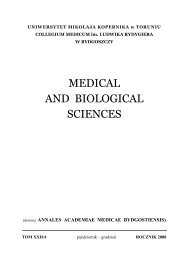Medical and Biological Sciences XXVI/2 - Collegium Medicum ...
Medical and Biological Sciences XXVI/2 - Collegium Medicum ...
Medical and Biological Sciences XXVI/2 - Collegium Medicum ...
Create successful ePaper yourself
Turn your PDF publications into a flip-book with our unique Google optimized e-Paper software.
34<br />
Bożenna Mazalska et. al.<br />
INTRODUCTION<br />
Fungi <strong>and</strong> straminipilous organisms exhibit a<br />
specific activity, colonizing cellulose, lignin, chitin <strong>and</strong><br />
keratin, i.e. the organic material of complex<br />
polymerized structure difficult to access by other<br />
microorganism [1]. These important destruents use the<br />
organic matter for the growth <strong>and</strong> spread of species,<br />
considerably contributing to self-purification of water<br />
reservoirs. During decomposition of dead plants <strong>and</strong><br />
animals, gradual mineralization occurs with release of<br />
elements that pass into the circulation. Partly<br />
decomposed biomass is included in the trophic chain<br />
consisting of subsequent consumers [2,3].<br />
The study objective was to establish species<br />
diversity of fungi <strong>and</strong> straminipila in water samples<br />
collected from a few bathing sites in the vicinity of<br />
Białystok, to identify or exclude potential etiologic<br />
factors for mycotic infections affecting humans <strong>and</strong><br />
animals, <strong>and</strong> to determine the effect of<br />
physicochemical parameters of the waters examined on<br />
the growth of this group of destruents.<br />
MATERIAL AND METHODS<br />
Description of study area<br />
Mycological investigations were conducted in<br />
2006-2007 in two seasons - spring <strong>and</strong> autumn <strong>and</strong><br />
involved four bathing sites:<br />
- bathing site in Dojlidy localized near Białystok:<br />
area 34.2 ha, max. depth 2.85 m, its south shore<br />
bordered by coniferous woods <strong>and</strong> its western part with<br />
the town of Białystok; the samples were collected from<br />
the western end of this pond, which is used by the<br />
inhabitants of the town as a beach;<br />
- bathing site in Korycin situated in the west<br />
Korycin Reservoir, covering an area of 6.8 ha, mean<br />
depth 1.35 m. fed by the river Kumiałka;<br />
- two bathing sites on the river Supraśl in the town<br />
of Supraśl (41 km of its middle course) <strong>and</strong> in Jurowce<br />
(19 km of the middle course). The river Supraśl, 93.8<br />
km long, covering an area of 1844.4 km 2 is a right<br />
tributary of the river Narew <strong>and</strong> its surface intake is a<br />
source of drinking water supply for inhabitants of<br />
Białystok <strong>and</strong> its vicinity. The river, due to the unique<br />
l<strong>and</strong>scape assets of the Knyszyńska Forest (boreal<br />
forest resembling southern taiga) is a recreational place<br />
for the region inhabitants <strong>and</strong> tourists visiting Podlasie<br />
[4].<br />
Mycological investigations<br />
For the analysis of fungi <strong>and</strong> straminipilous<br />
organisms 3 samples were collected from each<br />
sampling site. The water collected from the respective<br />
reservoir was poured in sterile conditions into beakers,<br />
0.6 l capacity, <strong>and</strong> placed in the laboratory in<br />
conditions resembling those of the natural<br />
environment. Baiting method described by Fuller <strong>and</strong><br />
Jaworski [5], Kiziewicz <strong>and</strong> Czeczuga [6] was used to<br />
isolate the fungi from the water. The following baits<br />
were used: amphipod crustacean Gammarus pulex,<br />
snake skin Natrix natrix, clover seeds of Trifolium<br />
repens, hemp seeds Cannabis sativa <strong>and</strong> buckwheat<br />
seeds Fagopyrum esculentum, <strong>and</strong> onion skin Alium<br />
cepa. Prior to being added to water samples all the<br />
substrates were boiled <strong>and</strong> rinsed with distilled water a<br />
few times. The baits were successively observed under<br />
an optic microscope (100 <strong>and</strong> 400x magnification)<br />
every 3-5 days, starting from day 3 of the culture.<br />
Next, several microscope preparations were prepared<br />
from each sample. The samples were stored for about a<br />
month to detect fungal physiology associated with<br />
sexual <strong>and</strong> asexual reproduction.<br />
Fungi were identified, taking into consideration the<br />
following morphological features: the shape <strong>and</strong> size of<br />
the tallum, the shape of sporangium <strong>and</strong> spores, the<br />
structure of the oogonium, antheridium <strong>and</strong> oospora.<br />
Works of many authors were used to determine the<br />
fungi [7-11].<br />
Physicochemical investigation<br />
Water samples were collected at each study site at a<br />
depth of 0.20 m, by means of a Ruttner’s apparatus<br />
(vol. 2.0 dm 3 ). Physicochemical analyses of<br />
temperature, pH, ammonium nitrogen, nitrite nitrogen<br />
<strong>and</strong> nitrate nitrogen, phosphates, chlorides <strong>and</strong><br />
sulphates were performed. St<strong>and</strong>ard methods as<br />
described by [12, 13] were employed for<br />
physicochemical investigations.<br />
RESULTS<br />
The physicochemical analysis of water used for the<br />
experiments revealed that the highest temperature was<br />
recorded in the water in bath Dojlidy (13.2°C),<br />
whereas the lowest in the bath Korycin (11.5°C)<br />
(Fig. 1).<br />
The highest pH was in the baths Jurowce (7.90),<br />
whereas the lowest in the baths Korycin (6.67) (Fig.2).

















